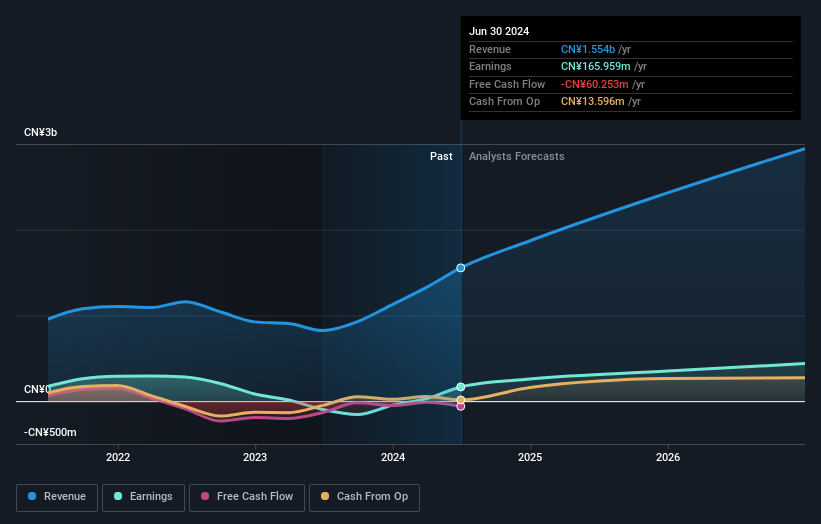- China
- /
- Semiconductors
- /
- SHSE:688766
Puya Semiconductor (Shanghai) Co., Ltd.'s (SHSE:688766) most bullish insider, CEO Nan Wang must be pleased with the recent 22% gain

Key Insights
- Puya Semiconductor (Shanghai)'s significant insider ownership suggests inherent interests in company's expansion
- The top 3 shareholders own 52% of the company
- Institutions own 28% of Puya Semiconductor (Shanghai)
To get a sense of who is truly in control of Puya Semiconductor (Shanghai) Co., Ltd. (SHSE:688766), it is important to understand the ownership structure of the business. And the group that holds the biggest piece of the pie are individual insiders with 33% ownership. In other words, the group stands to gain the most (or lose the most) from their investment into the company.
As a result, insiders scored the highest last week as the company hit CN¥7.3b market cap following a 22% gain in the stock.
Let's delve deeper into each type of owner of Puya Semiconductor (Shanghai), beginning with the chart below.
View our latest analysis for Puya Semiconductor (Shanghai)

What Does The Institutional Ownership Tell Us About Puya Semiconductor (Shanghai)?
Institutions typically measure themselves against a benchmark when reporting to their own investors, so they often become more enthusiastic about a stock once it's included in a major index. We would expect most companies to have some institutions on the register, especially if they are growing.
We can see that Puya Semiconductor (Shanghai) does have institutional investors; and they hold a good portion of the company's stock. This implies the analysts working for those institutions have looked at the stock and they like it. But just like anyone else, they could be wrong. If multiple institutions change their view on a stock at the same time, you could see the share price drop fast. It's therefore worth looking at Puya Semiconductor (Shanghai)'s earnings history below. Of course, the future is what really matters.

Hedge funds don't have many shares in Puya Semiconductor (Shanghai). Looking at our data, we can see that the largest shareholder is the CEO Nan Wang with 26% of shares outstanding. With 18% and 6.8% of the shares outstanding respectively, Shanghai Zhiqi Enterprise Management Consulting Partnership Enterprise (Limited Partnership) and Zhaogui Li are the second and third largest shareholders. Interestingly, the third-largest shareholder, Zhaogui Li is also a Member of the Board of Directors, again, indicating strong insider ownership amongst the company's top shareholders.
After doing some more digging, we found that the top 3 shareholders collectively control more than half of the company's shares, implying that they have considerable power to influence the company's decisions.
While studying institutional ownership for a company can add value to your research, it is also a good practice to research analyst recommendations to get a deeper understand of a stock's expected performance. There are a reasonable number of analysts covering the stock, so it might be useful to find out their aggregate view on the future.
Insider Ownership Of Puya Semiconductor (Shanghai)
While the precise definition of an insider can be subjective, almost everyone considers board members to be insiders. Management ultimately answers to the board. However, it is not uncommon for managers to be executive board members, especially if they are a founder or the CEO.
Most consider insider ownership a positive because it can indicate the board is well aligned with other shareholders. However, on some occasions too much power is concentrated within this group.
Our most recent data indicates that insiders own a reasonable proportion of Puya Semiconductor (Shanghai) Co., Ltd.. Insiders own CN¥2.4b worth of shares in the CN¥7.3b company. That's quite meaningful. It is good to see this level of investment. You can check here to see if those insiders have been buying recently.
General Public Ownership
The general public-- including retail investors -- own 20% stake in the company, and hence can't easily be ignored. While this size of ownership may not be enough to sway a policy decision in their favour, they can still make a collective impact on company policies.
Private Company Ownership
It seems that Private Companies own 18%, of the Puya Semiconductor (Shanghai) stock. It's hard to draw any conclusions from this fact alone, so its worth looking into who owns those private companies. Sometimes insiders or other related parties have an interest in shares in a public company through a separate private company.
Next Steps:
It's always worth thinking about the different groups who own shares in a company. But to understand Puya Semiconductor (Shanghai) better, we need to consider many other factors. Case in point: We've spotted 2 warning signs for Puya Semiconductor (Shanghai) you should be aware of, and 1 of them is a bit concerning.
Ultimately the future is most important. You can access this free report on analyst forecasts for the company.
NB: Figures in this article are calculated using data from the last twelve months, which refer to the 12-month period ending on the last date of the month the financial statement is dated. This may not be consistent with full year annual report figures.
New: Manage All Your Stock Portfolios in One Place
We've created the ultimate portfolio companion for stock investors, and it's free.
• Connect an unlimited number of Portfolios and see your total in one currency
• Be alerted to new Warning Signs or Risks via email or mobile
• Track the Fair Value of your stocks
Have feedback on this article? Concerned about the content? Get in touch with us directly. Alternatively, email editorial-team (at) simplywallst.com.
This article by Simply Wall St is general in nature. We provide commentary based on historical data and analyst forecasts only using an unbiased methodology and our articles are not intended to be financial advice. It does not constitute a recommendation to buy or sell any stock, and does not take account of your objectives, or your financial situation. We aim to bring you long-term focused analysis driven by fundamental data. Note that our analysis may not factor in the latest price-sensitive company announcements or qualitative material. Simply Wall St has no position in any stocks mentioned.
About SHSE:688766
Puya Semiconductor (Shanghai)
Engages in design and sale of non-volatile memory chips and derivative chips based on memory chips in China and internationally.
Flawless balance sheet with high growth potential.


